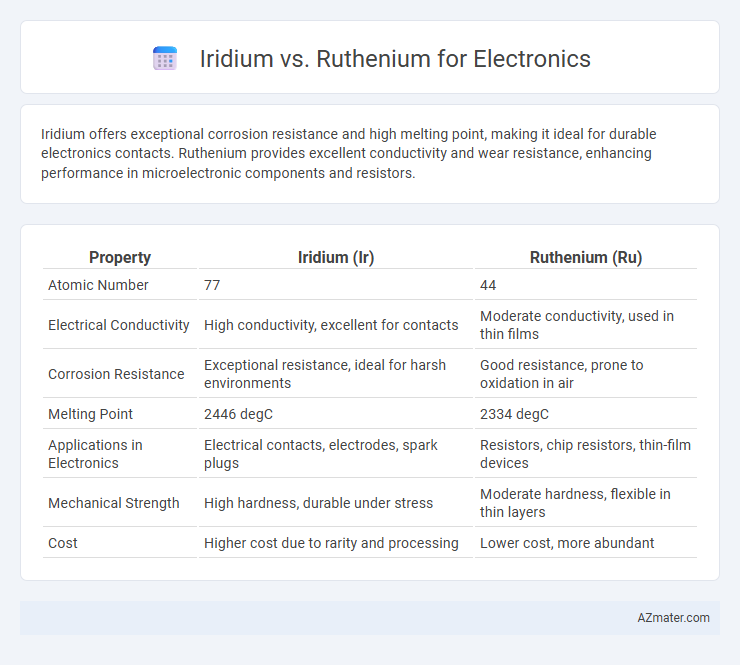Iridium offers exceptional corrosion resistance and high melting point, making it ideal for durable electronics contacts. Ruthenium provides excellent conductivity and wear resistance, enhancing performance in microelectronic components and resistors.
Table of Comparison
| Property | Iridium (Ir) | Ruthenium (Ru) |
|---|---|---|
| Atomic Number | 77 | 44 |
| Electrical Conductivity | High conductivity, excellent for contacts | Moderate conductivity, used in thin films |
| Corrosion Resistance | Exceptional resistance, ideal for harsh environments | Good resistance, prone to oxidation in air |
| Melting Point | 2446 degC | 2334 degC |
| Applications in Electronics | Electrical contacts, electrodes, spark plugs | Resistors, chip resistors, thin-film devices |
| Mechanical Strength | High hardness, durable under stress | Moderate hardness, flexible in thin layers |
| Cost | Higher cost due to rarity and processing | Lower cost, more abundant |
Introduction to Iridium and Ruthenium in Electronics
Iridium and ruthenium, both members of the platinum group metals, play significant roles in electronics due to their unique physical and chemical properties. Iridium is prized for its exceptional corrosion resistance and high melting point, making it ideal for electrical contacts and spark plugs in harsh environments. Ruthenium enhances the performance of electronic components through its excellent conductivity and wear resistance, often used in thin film resistors and hard disk drives.
Material Properties: Iridium vs Ruthenium
Iridium exhibits exceptional corrosion resistance, high melting point (2446degC), and superior electrical conductivity, making it ideal for harsh electronic environments. Ruthenium offers excellent hardness, moderate melting point (2334degC), and good resistance to wear, often used as a thin-film material in resistors and contacts. Both metals provide unique advantages in electronics: iridium excels in durability and stability under extreme conditions, while ruthenium supports miniaturization and reliability in semiconductor components.
Electrical Conductivity Comparison
Iridium and ruthenium are both transition metals with distinct electrical conductivity properties critical for electronics applications. Iridium exhibits a higher electrical conductivity of approximately 17.1 million Siemens per meter (MS/m) compared to ruthenium's conductivity of around 14.6 MS/m, making iridium more efficient for minimizing energy loss in electronic circuits. Ruthenium, while slightly less conductive, offers superior corrosion resistance and stability at high temperatures, which can be advantageous in specialized electronic components.
Corrosion and Oxidation Resistance
Iridium exhibits superior corrosion and oxidation resistance compared to ruthenium, making it highly valuable for electronics exposed to harsh environments or high temperatures. Ruthenium, while offering moderate resistance, tends to form oxides more readily, which can compromise long-term device reliability. The enhanced stability of iridium ensures prolonged performance and durability in critical electronic components such as contacts, electrodes, and circuit boards.
Manufacturing and Processing Differences
Iridium exhibits exceptional corrosion resistance and high melting point, making it suitable for harsh electronic environments but challenging to machine and process due to its brittleness and density. Ruthenium, with its lower melting point and greater ductility, enables easier fabrication, especially in thin-film applications like resistors and contacts, offering cost-effective manufacturing advantages. The differences in crystal structure and chemical reactivity between Iridium and Ruthenium significantly influence their respective deposition methods and integration in semiconductor device production.
Cost and Availability in the Market
Iridium and ruthenium are both rare platinum-group metals used in electronics, but ruthenium is generally more affordable and more abundant in the market, making it a cost-effective choice for mass production. Iridium's scarcity and high extraction costs lead to significantly higher prices, which can limit its use to specialized high-performance electronic components. While both metals offer excellent corrosion resistance and conductivity, ruthenium's better market availability ensures a more stable supply chain for electronic manufacturers.
Applications in Electronic Components
Iridium and ruthenium are both platinum-group metals with unique properties that enhance electronic components' performance. Iridium's high corrosion resistance and excellent conductivity make it ideal for electrical contacts, spark plugs, and electrodes in harsh environments. Ruthenium is widely used as a thin-film resistor material and in chip resistors, improving durability and electrical stability in integrated circuits and memory devices.
Performance in Microelectronics
Iridium and ruthenium are critical metals in microelectronics due to their unique electrical properties and stability. Ruthenium, with its excellent conductivity and resistance to oxidation, is frequently used for thin-film resistors and electrode contacts, enhancing device performance and longevity. Iridium, characterized by higher corrosion resistance and thermal stability, is preferred in high-reliability circuits and microelectromechanical systems (MEMS), where durability under extreme conditions is essential.
Environmental and Safety Considerations
Iridium exhibits superior corrosion resistance and stability in harsh electronic environments, minimizing hazardous material degradation risks compared to ruthenium. Ruthenium, though effective for electronic contacts and resistors, poses higher environmental concerns due to potential toxicity and bioaccumulation in aquatic ecosystems. Both metals require careful handling and recycling protocols to mitigate occupational exposure and environmental contamination during manufacturing and disposal processes.
Future Trends and Research Directions
Iridium and ruthenium are increasingly explored for advanced electronics due to their unique catalytic and conductive properties, with ruthenium gaining prominence in resistive random-access memory (RRAM) and iridium in spintronic devices. Future trends highlight ruthenium's potential in neuromorphic computing and energy-efficient memory technologies, driven by its excellent scaling and endurance characteristics. Research is focusing on atomic-level interface engineering and alloy development to enhance the performance and integration of iridium and ruthenium in next-generation electronic components.

Infographic: Iridium vs Ruthenium for Electronics
 azmater.com
azmater.com